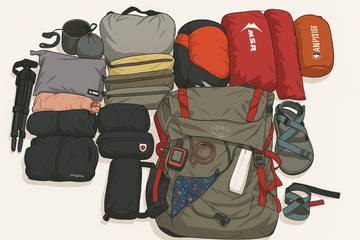When I first got into multi-day hiking, I thought I needed to bring everything to stay "comfortable." Later, I swung the other way — obsessing over ultralight lists and trying to cut every gram. The truth is: you don't need to spend a fortune or become a ultralight hiker to enjoy a multi-day trek with comfort.
After hiking multiple multi-day tracks across Australia and overseas — from Tasmania’s Overland Track, O-Circuit in Patagonia, Everest Base Camp, and more, I’ve learnt a few lessons.
It’s so easy to overpack when you’re new to hiking. I’ve done it too. But after carrying every gram on my back day after day, I figured out what’s truly essential, and what’s just dead weight. Here’s the real list you need if you want to enjoy your next multi-day hike (without breaking your back).
Essentials for Any Multi-Day Hike
- Backpack: A lightweight pack (50–65L) that fits you properly
- Tent: Lightweight, 3-season tent (or 4-season if heading into snow)
-
Sleeping System:
- Sleeping bag (temperature rated for your conditions)
- Sleeping mat (if inflatable, check the insulation rating to match weather conditions)
-
Cooking Gear:
- Lightweight stove and gas canister
- Small pot or pan
- Spork (long handle preferred)
- Lighter and waterproof matches
-
Hydration:
- Hydration bladder (2–3L)
- Plus an extra backup bottle (always have two water options)
- Water filter, UV pen, or purification tablets
- Navigation: Physical map (even if using GPS)
- Headlamp: Rechargeable headlamp (plus charging cable and small power bank)
- First Aid Kit: Include a snake bandage (especially important in Australia)
- Personal Safety Gear: Personal Locator Beacon (PLB) or satellite messenger (especially for solo hikers)
- Mini multi-tool or Knife
- Rain Gear: Lightweight rain jacket and pack cover
-
Clothing:
- Moisture-wicking base layers (merino preferred)
- Warm mid-layer (fleece or puffer jacket)
- Rain jacket (optional rain pants)
- Quick-dry hiking pants or shorts
- Spare underwear and socks
-
Footwear:
- Hiking boots or trail runners (well broken-in)
- Lightweight camp shoes (like Crocs or sandals)
- Sun Protection: Hat, sunglasses, sunscreen, lip balm
- Trekking Poles (optional but very useful)
Extras You Should Pack for Winter Hikes
- Thermal base layers (top and bottom)
- Inner and waterproof gloves and a warmer beanie
- Heavier sleeping bag (appropriate for freezing nights)
- Additional gas canister (fuel burns faster in cold temperatures)
- Microspikes or crampons (if icy conditions possible)
Personal Items and Toiletries
- Small toothpaste and toothbrush
- Tiny bottle of biodegradable soap
- Microfibre towel (optional)
- Reusable pee cloth (for women)
- Toilet paper and a lightweight trowel for digging a cathole
- Sunscreen and insect repellent
- Personal medications
Tip: Keep toiletries very minimal. It's perfectly fine not to shower for a week. You’ll get used to it — and you’ll probably swim in rivers and creeks along the way. No need for full-size soaps, shampoos, or heavy toiletry kits. Stay light and embrace it.
A Few (Optional) Extras
- E-book reader or lightweight book (for rest days or rainy evenings)
- Small power bank (for phone or headlamp recharging)
- Camera and small tripod (if you're into photography)
What You Think You Need (But Really Don't)
- Baby wipes: Heavy and bulky. Unless absolutely necessary, skip them. If you’ll have access to water, a small reusable cloth is a lighter, more sustainable option for freshening up along the way.
- Notebook and pen: Nice idea, but unnecessary weight unless you’re serious about journaling.
- Heavy multi-tools: A simple mini knife is enough.
- Multiple outfits: You don't need a fresh set of clothes for every day. If you invest in good-quality merino base layers, you only need one hiking set (the one you’re wearing), your rain and warm layers, and one dry set for camp. It’s all about layering, reusing, and staying dry when it counts.
- Complex cooking gear: Keep meals simple and minimal. Food can easily become one of the heaviest parts of your pack during a multi-day hike, especially if you’re carrying bulky or complicated ingredients. It’s important to keep meals simple — at the end of the day, we’re camping, and it’s totally fine to go a few days without luxuries. Focus on lightweight, easy meals that don't require a lot of fuel, equipment, or preparation time.
Quick Mention About Food
Food is a whole subject by itself (and I’ll cover it properly in a future post!). But here’s a quick overview:
- Store-bought Freeze-dried meals are lightweight and designed for hiking, but they can be expensive.
- Dehydrating our own meals at home is probably the best alternative for hiking meals. This way, you can control the ingredients, save money, and pack lightweight, nutritious meals. But of course, dehydrating isn’t for everyone — you’ll need a dehydrator, time to prepare, and some confidence with cooking.
-
DIY alternatives from the supermarket can be just as effective if you choose carefully:
- Tuna or salmon satchels
- Peanut butter satchels
- Instant rice
- Flavoured couscous
- Wraps instead of bread
- Instant noodles are cheap, lightweight, and easy to cook — but they are very low in nutrients. They’re fine occasionally, but shouldn’t be your main source of energy on longer hikes.
When planning food for a multi-day hike:
- Expect to carry around 500g to 900g of food per day, depending on the hike's length, terrain, and how much you usually eat.
- Focus on calorie-dense and high-protein meals. You want foods that will fuel your body without taking up unnecessary weight or bulk.
- Prioritise meals that are quick to prepare and require minimal fuel and water.
Getting your food right is essential — the longer the hike, the more it matters.
Example Packing Lists
Want to see a real-world example? Here are two lighterpack links to give you a better idea:
They include full lists of gear, clothing, and food planning!
